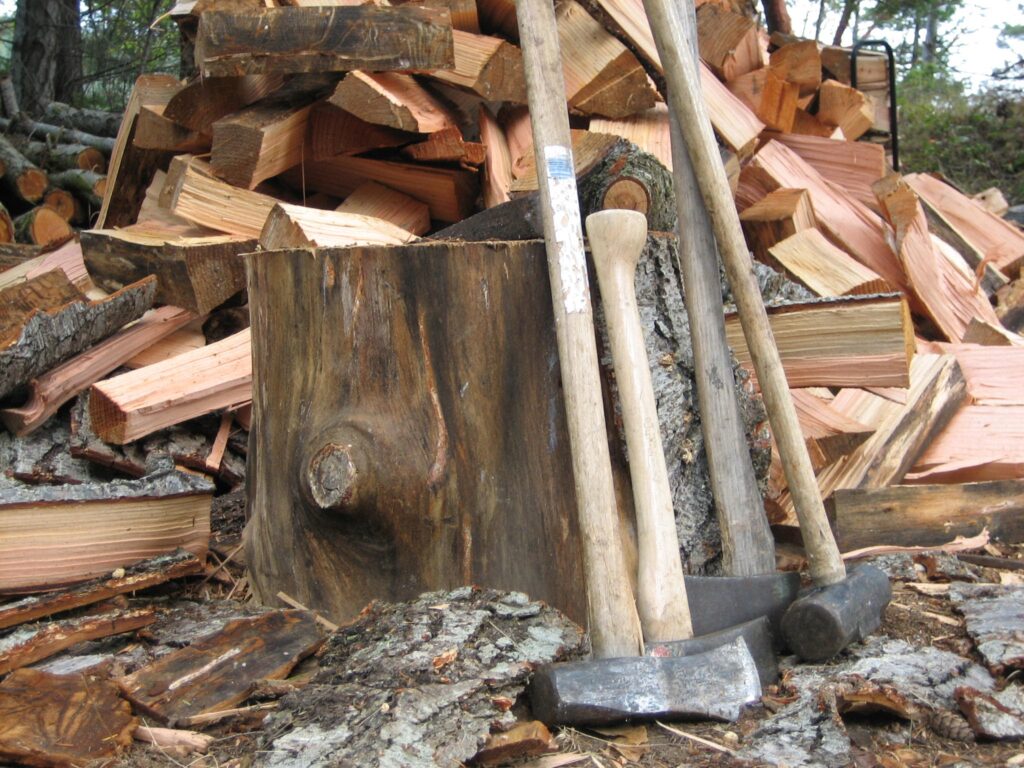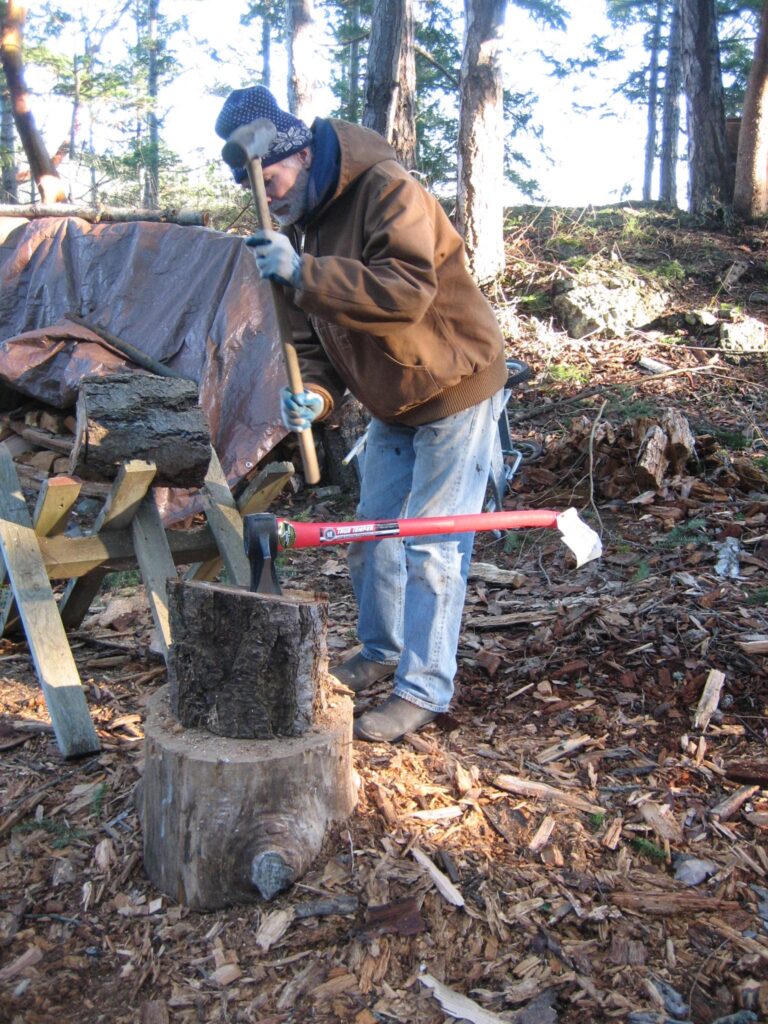2010 10 29 Friday
Last week, with our pickup temporarily on Crane and after cutting a number of fallen trees into 16″ sections, I brought home four loads of cut up trees and moved them to the front yard, outside Yvonne’s deer fence, ready for splitting. I already had two stacks I’d split during the summer and some left over from last year, all covered on top with tarps to protect from rain but open on the sides so that the wood would dry out. The larger stack smelled of mink scat and when retrieving wood to burn I’d found the remains of what appeared to be mink dinners. Mink often crossed our yard and last summer when I was working on stairs to our beach a mink ran right by me up the stairs without much worrying that I might be a danger.
We don’t expect to heat our house with wood but only to make it cozy, from time to time raising the house temperature above the 68 degree I’ve programmed into the thermostats for our primary, baseboard, electric heating system. With a wood fire, we can be cozy without increasing our electric bill. And since it is likely our electrical service will fail from time to time over the winter – after snow or wind or for some other reason – it makes sense to have a backup heating source. But how much wood did we need? Best to prepare while we had a truck on the island to carry wood home from where we scavenged it.
Some types of wood burn faster than others. Douglas fir burns slowly and contains lots of heat; alder burns much more quickly and produces less heat. So how much wood we needed would depend on what kind we had as well as how much heat we needed to generate each day. Too hard for me to figure exactly. What I did know was that in October, in the 40s and 50s we were using about 14 cubic feet of split wood each week. Assuming we wanted a fire in our wood stove mornings at least through May, and given some time away traveling, we’d need about 30 weeks worth or 420 cubic feet. A cord is 8′ long by 4′ high by 4′ deep or 128 cubic feet. We’d need 3 ½ cords. We had a bit less than two cords split and stacked and it looked like there was at least a cord ready for splitting. It wouldn’t hurt to have some more.

It took about two hours to split a week’s wood and a month’s kindling and to stack it on the porch. My guess is that I spent about 8 hours locating, cutting, and transporting a cord. Since a cord will last about 9 weeks, I spent a bit under an hour per week acquiring the wood. If the annual heating season is 34 weeks, we’ll use 476 cubic feet, I’ll spend 68 hours splitting and stacking, and 30 hours finding, cutting, and fetching; that’s about 100 hours per season. By supplementing our electric heat by burning wood we save about $600 on our annual heating bill, which means I’m “making” about $6/hour, or maybe $8/hour gross considering the withholding and taxes it would cost to net $6/hour. On Orcas a cord costs about $200 so it would cost about the same to heat with purchased wood as with electricity. I enjoy the process of finding and splitting wood and the exercise is a plus. And having firewood gives us two sources of heat and that’s important living in the islands.
Eighteen months ago I brought a good-sized fir, in sections, to Crane from Chris Thomerson’s house in Deer Harbor on Orcas. The tree had died, it was down and cut in sections, and Chris wanted to get rid of it so I carried the tree to Crane in a number of round trips. I’d load my pickup, drive the load to the head of the Crane dock on Orcas, cart the wood down to our boat at the dock, drive our boat to Crane, unload the trunk sections into our dock cart, and then wrestle the dock cart to our house two hundred yards away. The lower sections of the tree were close to two feet across and weighed more than I could lift but I did it anyway and when lifting the last section out of our boat to the dock I did something to my back that took a week to recover from. But that wide, heavy stump section became an excellent splitting platform.
At Christmas, rather than each person in the family giving every other a present, we each become a Secret Santa for one person. Last Christmas my Secret Santa gave me a True-Temper fiberglass-handled splitting maul to replace my wooden handled model that was cracked and had become unsafe and nearly useless. An axe head expands to 1 ½ inches at the back; a splitting maul to 3 inches half-way back. A sharp axe can be used to chop horizontally across the trunk of a tree, creating a triangular cut across the grain but it does poorly chopping vertically into a trunk section, with the grain, because the axe gets stuck easily. A splitting maul, on the other hand, does well coming down on the top of a section and the further it penetrates the wood the further it forces the wood apart, usually splitting an 8″ high section in one blow.

Cedar splits straight and lights easily so I use it to make kindling – 12″ sticks mostly less than an inch on a side. Fir and alder split straight too but not as easily. Other island trees, maple, madrona, and willow, are much harder to split and so aren’t desirable firewood.
If trunk sections are cut more or less perpendicularly to the trunk, they are stable once set on a splitting block and easy to split. Generally I aim the first blow at the middle of the section. I may then split the results again – until I’ve got something 4″ or less at its thickest point. But that first stroke doesn’t always split the section. If the wood is too soft, as was some of the wood I scavenged last week, the stroke buries the head but doesn’t split the section. In that case I bury the head further by hitting the rear of the maul with a ten pound sledge hammer until the wood splits. Sometimes it doesn’t and then I have to back the splitting maul out of the section by tapping the handle with the sledge hammer until it starts to exit the section. Trunk sections from which now trimmed branches emerged can also be difficult to split.
There is a pleasure in choosing the right place to strike a trunk section – sometimes based on characteristics of that specific section, – and then raising the maul and bringing it down hard on the wood, the section splitting with a satisfying crack. When freshly split Douglas fir sometimes has a recognizable fragrance and cedar almost always does.
Deciding on a splitting strategy for a trunk section, choosing where to strike, raising the maul, hitting the wood hard, hearing the sound of splitting, and then smelling the fragrance of the split wood is always deeply satisfying. During today’s splitting session I could hear the occasional sound of waves lapping on Ochs’ beach about 100′ feet away, the cry of seagulls, ravens vocalizing, the deep rumbling of a ferry passing through Wasp Passage to the south, and the piercing but rich sound of a whistle from an Orcas steam-powered boat. Heaven on a small island in the San Juans.
© 2020, johnashenhurst. All rights reserved.
